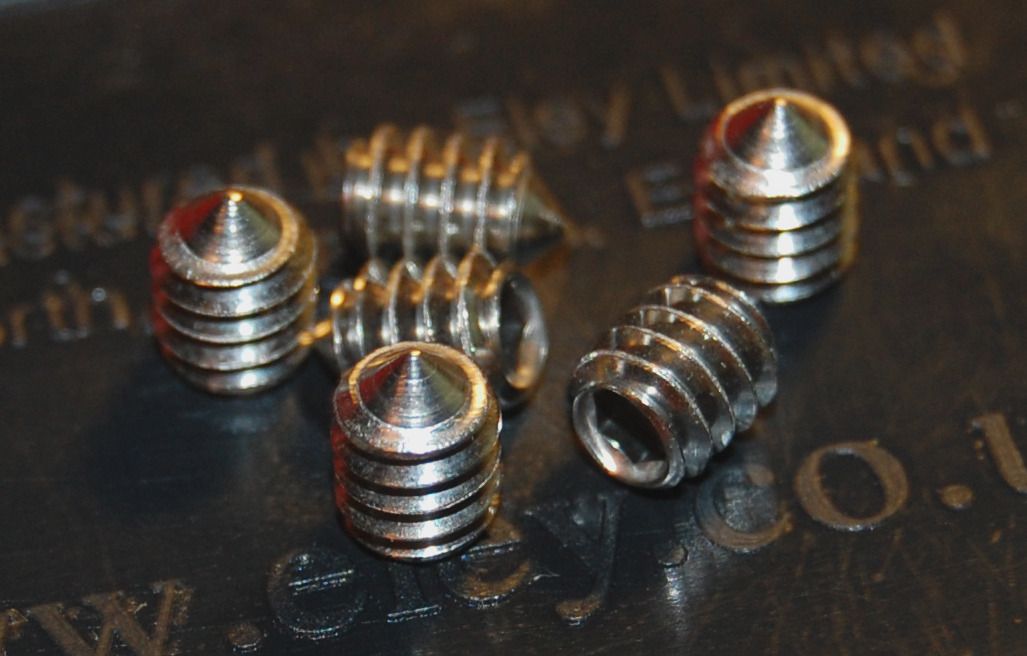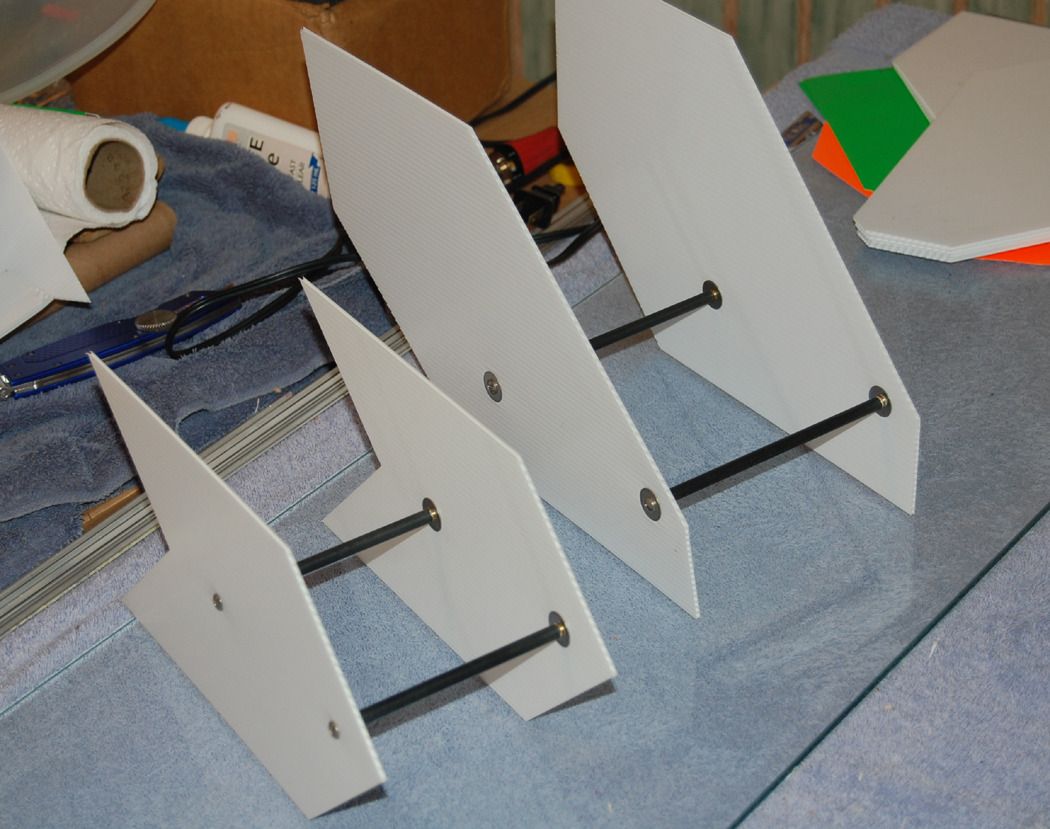You are using an out of date browser. It may not display this or other websites correctly.
You should upgrade or use an alternative browser.
You should upgrade or use an alternative browser.
M
mks
Guest
Bingo! But the pivot needs to offer as low a friction coefficient as possible...because there WILL BE side contact, even on a flag that is pefectly balanced in a true calm(static) condition,it won't be once the wind offers enough force to move it. Drag will make it tail heavy.
Mike,
You make a good point about the force on the pivot changing with wind speed. One way to reduce this change is to align all forces through the pivot, so that the wind force does not put a torque around the horizontal shaft of flag, causing the pivot to rub the post. This would argue for vanes centered around the shaft, rather than high or low vanes, as well as sail tails attached at the level of the shaft rather than being high or low.
Keith
S
SGJennings
Guest
Yes.
No. Fishtailing is not a balance nor a static stability problem. It is a different problem, a dynamic problem involving the sail area, rotational inertia and damping. Yes, you can reduce fishtailing by increasing sail area or its distance from the pivot, but you can also reduce it by decreasing inertia and increasing damping.
Show me where I said "static". You can't restate what I said and then rebuff your restatement...unless you are a politician.
M
mks
Guest
Keith, maybe you can help me with another question pertaining to to subject of wind flags.
Lets talk daisies for a minute. What effect, if any does the rotation of the daisy have on its relative mass?
None. It's weight is still the same and is still centered on the shaft, regardless of its orientation. But there is a gyroscopic effect that resists rotation around the pivot. I doubt that this effect is very large for pinwheels, but daisies are a lot heavier. It would be a nice project for Jason's students to see if they could measure this!
M
mks
Guest
2. Zero friction also means zero dampening. Like a car with no shock absorbers.
Now we are getting somewhere! To get a dynamic system to behave, damping can be very important. Friction between solids can be problematic, because the two surfaces can stick. Not a good thing for a wind flag. But something like a shock absorber, which uses a viscous fluid, in principle doesn't stick. That was the idea behind my viscous damping flag pivots.
M
mks
Guest
Show me where I said "static". You can't restate what I said and then rebuff your restatement...unless you are a politician.
Greg,
You didn't say "static." That's my interpretation of your #2. If that's not what you meant, I apologize.
Sorry,
Keith
S
SGJennings
Guest
Once upon a time, I did the software that implemented aircraft control laws. I suspect that I could put together a pretty good control law for the flags. But, there would have to be sensors, something to do the dampening, a microprocessor, yadda, yadda.
Or, you could just go up to Auburn and get a set of Ezell's flags and get a set of Halblom's sail tails. In practice, the combo is hard to beat.
There are three improvements that I would like to implement.
1. I wish that there was some way for the pinwheels to be unfold for transport.
2. I need to find some kind of knuckle that will let me level them. I don't always get the pole straight.
3. I need to find a lighter version of the sail tail for calm days shooting that itty bitty X on the Miami Rifle and Pistol 100 yard target.
Or, you could just go up to Auburn and get a set of Ezell's flags and get a set of Halblom's sail tails. In practice, the combo is hard to beat.
There are three improvements that I would like to implement.
1. I wish that there was some way for the pinwheels to be unfold for transport.
2. I need to find some kind of knuckle that will let me level them. I don't always get the pole straight.
3. I need to find a lighter version of the sail tail for calm days shooting that itty bitty X on the Miami Rifle and Pistol 100 yard target.
S
SGJennings
Guest
The Aussies pinwheel folds flat. That is really the only thing that strikes me about them.
Gene Beggs
Active member
Good discussion.
This is a good discussion about a subject that has been near and dear to my heart ever since I got involved in benchrest back in the eighties. Keep it up guys; I'm listening carefully.
Again may I say that if you haven't studied the chapter on wind flags in Mike Ratigan's book, "Extreme Rifle Accuracy" you should do so.
My advice;
(1) Keep it simple.
(2) Avoid tunnel vision.
Gene Beggs
This is a good discussion about a subject that has been near and dear to my heart ever since I got involved in benchrest back in the eighties. Keep it up guys; I'm listening carefully.
Again may I say that if you haven't studied the chapter on wind flags in Mike Ratigan's book, "Extreme Rifle Accuracy" you should do so.
My advice;
(1) Keep it simple.
(2) Avoid tunnel vision.
Gene Beggs
Apollo
Jason Stanley
"It would be a nice project for Jason's students to see if they could measure this!"
That would be a cool one. We kind-of did that. The windshield wiper effect (the time when the flag "settled in" minus the time when the flag first moved) results were virtually the same if we had daisies on or just a counter weight. All flags took a little while to "settle in". It really didn't matter if we had the daisy on or not.
However, the initial reaction time was longer in all cases, except 1, with the daisy than without. That is not reading that all flags had the same reaction time, just that most all flags were slower to react with daisies than without.
Keith - I found a hard copy of the data, but am having trouble locating the saved excell spreadsheet. I'll keep looking.
I might try and do a wind flag project again next year - this year we are helping the power drive cars figure out a way to go longer/faster on a 12volt battery.
That would be a cool one. We kind-of did that. The windshield wiper effect (the time when the flag "settled in" minus the time when the flag first moved) results were virtually the same if we had daisies on or just a counter weight. All flags took a little while to "settle in". It really didn't matter if we had the daisy on or not.
However, the initial reaction time was longer in all cases, except 1, with the daisy than without. That is not reading that all flags had the same reaction time, just that most all flags were slower to react with daisies than without.
Keith - I found a hard copy of the data, but am having trouble locating the saved excell spreadsheet. I'll keep looking.
I might try and do a wind flag project again next year - this year we are helping the power drive cars figure out a way to go longer/faster on a 12volt battery.
Last edited:
Vern
Morethan1waytoskinacat
Sorry for the delay, WORK.
Jerry is correct I use them between the stud and the pivot in an opposing fashion to eliminate any friction there.
The base is stainless and the flag part of the pivot is delrin.
The only friction is between the stud and the hole its in..
Considering some products to reduce friction there even further.
Jerry is correct I use them between the stud and the pivot in an opposing fashion to eliminate any friction there.
The base is stainless and the flag part of the pivot is delrin.
The only friction is between the stud and the hole its in..
Considering some products to reduce friction there even further.
A
Andy Cross
Guest
On the subject of pivots
Years ago I met someone here in Oz who had made a couple of prototypes of wind flags that used a pivot that had a ball floating on mercury. The frictional drag he said was reduced to parctically nothing. Don't know what become of him or the project. Has anyone looked at doing this in the US.
Andy.
Mike,
You make a good point about the force on the pivot changing with wind speed. One way to reduce this change is to align all forces through the pivot, so that the wind force does not put a torque around the horizontal shaft of flag, causing the pivot to rub the post. This would argue for vanes centered around the shaft, rather than high or low vanes, as well as sail tails attached at the level of the shaft rather than being high or low.
Keith
Years ago I met someone here in Oz who had made a couple of prototypes of wind flags that used a pivot that had a ball floating on mercury. The frictional drag he said was reduced to parctically nothing. Don't know what become of him or the project. Has anyone looked at doing this in the US.
Andy.
S
SGJennings
Guest
Hope the Hg was super sealed. Mercury poisoning is for real.
A
Andy Cross
Guest
Merc poisoning
I was having dinner with a friend the other evening who is a physician. As I make my living as a photograpaher these days I am well versed with the evils of the darkroom and still run one today but for my own art photography.
The conversation over dinner came up about the various ways people affected their health in the darkroom. Mostly through stupidity but the subject of mercury came up. Did you know that you could swallow a mouth full of the silver liquid metal and it would not be absorbed by the body. You would just pass sparkling excrement for a while. Just don't heat it and breath the vapours.
Andy.
Andy because of the word Mercury, probably not.
I was having dinner with a friend the other evening who is a physician. As I make my living as a photograpaher these days I am well versed with the evils of the darkroom and still run one today but for my own art photography.
The conversation over dinner came up about the various ways people affected their health in the darkroom. Mostly through stupidity but the subject of mercury came up. Did you know that you could swallow a mouth full of the silver liquid metal and it would not be absorbed by the body. You would just pass sparkling excrement for a while. Just don't heat it and breath the vapours.
Andy.
S
SGJennings
Guest
It *is* entirely correct that *elemental* Hg is poorly absorbed in through the skin or intestinal tract.
It is compounds of Hg, including mercury chloride, that are highly toxic. I don't know much about photography. I do know that mercury chloride was historically used in darkroom photography.
So, what happens out in the field, where there is UV, there are various cleaning compounds, there are hydrocarbons, etc?
Me, I'll just stick with the virgin teflon/polished stainless steel "bearings" on my flags.
It is compounds of Hg, including mercury chloride, that are highly toxic. I don't know much about photography. I do know that mercury chloride was historically used in darkroom photography.
So, what happens out in the field, where there is UV, there are various cleaning compounds, there are hydrocarbons, etc?
Me, I'll just stick with the virgin teflon/polished stainless steel "bearings" on my flags.



